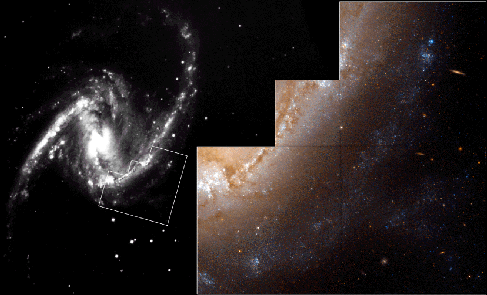
|
Explanation: Our Universe is expanding. Distant galaxies appear to recede from us at ever-increasing speeds. What is the rate of expansion? How long has it been expanding? What will be its ultimate fate? Two groups of astronomers are searching vigorously for answers to these fundamental questions using the Hubble Space Telescope (HST). The teams have recently announced conflicting measurements of the Hubble constant, a number which represents the expansion rate of the Universe. Astronomer Wendy Freedman and her collaborators have used pulsating stars called Cepheids to measure the distance to galaxies like the Fornax cluster barred spiral galaxy NGC1365 shown above. The ground based photo (left) shows an inset locating the HST image (right) which Freedman and team have used to identify some 50 Cepheids. Their distance and velocity measurements determine Hubble's constant to be about 80 kilometers per second per megaparsec which means that galaxies one megaparsec (3 million lightyears) distant appear to recede from us at a speed of 80 kilometers per second. Conflicting results indicating a substantially slower expansion rate (smaller Hubble constant) are being reported by astronomer Allan Sandage and collaborators. The value of Hubble's constant was recently the subject of a popular public debate titled "The Scale of the Universe 1996: The Value of Hubble's Constant".
|
January February March April May June July August September October November December |
| ||||||||||||||||||||||||||||||||||||||||||||||||
NASA Web Site Statements, Warnings, and Disclaimers
NASA Official: Jay Norris. Specific rights apply.
A service of: LHEA at NASA / GSFC
& Michigan Tech. U.
Based on Astronomy Picture
Of the Day
Publications with keywords: universe - HST
Publications with words: universe - HST
See also:
